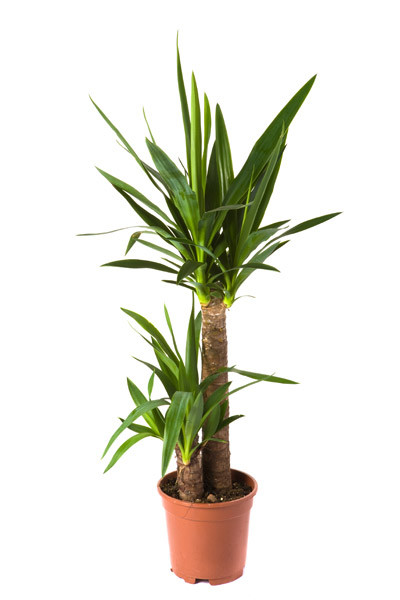 Yucca home careHomeland: North America. A beautiful evergreen plant with linear, spiny-pointed leaves. The leaves are collected in an ornamental rosette at the end of the trunk. In appearance, it is very similar to dracaena with green leaves (but has no relationship with it) and is just as hardy and does not present any problems in culture.
Yucca home careHomeland: North America. A beautiful evergreen plant with linear, spiny-pointed leaves. The leaves are collected in an ornamental rosette at the end of the trunk. In appearance, it is very similar to dracaena with green leaves (but has no relationship with it) and is just as hardy and does not present any problems in culture.
- Yucca aloelista Yucca aloifolia - has a thick rosette of xiphoid leaves, up to 55 cm long The leaves have very sharp tips. It has a pronounced trunk.
- Yucca elephant Yucca elephantipes - similar toprevious view, but the tips of its leaves are not sharp. The most common type that is commercially available. Usually it is sold as a rooted thick tree stalk, having several rosettes of leaves. It grows slowly, reaching a height of about 1.5 meters.
Growing a large plant takes timeas yucca is a slow growing plant. From mid-May to the end of September, it can be taken out on a balcony, terrace or garden, in an open sunny place (previously prepared for the sun’s rays, exposing it first in a light shade). Yuccas are good in that they are immune to the dry air of the rooms, and this, many people know, is not unimportant.
Care Tips
 Temperature: Moderate, cool in winter - preferably 16-18 ° C, but not below 8 ° C. In winter, when keeping yucca in normal room conditions, it is necessary to ventilate the room, but avoid cold drafts. Lighting: A bright, sunny place. In summer, the yucca prefers outdoor seating - on the balcony, in the garden, etc. In winter, the yucca will have to be moved as close as possible to the window, since in winter these plants especially suffer from a lack of light - and the leaf fan will not be lush and thick. : Abundant from spring to autumn, but at the same time water should not remain on the pallet, in winter watering is moderate. If you keep in cold conditions in winter, then watering is rare, but does not allow over-drying of the earthy coma. Yucca does not tolerate stagnant water in the soil - this can lead to rotting of the roots and the formation of stem rot. Humidity: Does not require spraying the leaves, but sometimes it is necessary to arrange washing, so that the plant does not become dusty and does not lose its attractiveness. In the summer, rain washes in the open air. If in winter a yucca is kept in a room with central heating, it is advisable to spray at least once a day. Transplant: The soil must be nutritious. For young plants - 2 parts of sod land, 2 parts of leafy land, 1 part of humus and 2 parts of sand. For adults and old plants - 3 parts of sod land, 2 parts of leaf, 2 parts of sand. Yucca is transplanted every two years in the spring. Yucca is planted in a large pot or tub. Good drainage is a must. From April to August, every two weeks fertilizers are fertilized, which significantly accelerates growth. Reproduction: In spring, rooting the top of the stem, as well as pieces of the trunk (at least 10 cm long). Reproduction by seeds and offspring is possible. During the reproduction of yucca by offspring, the daughter outlet is cut off from the main stem with a sharp knife, and the cut point on the trunk is sprinkled with gray. The cut rosette is rooted in wet sand, and after rooting, it is planted in a pot with soil, into which pieces of wood (for example, birch) coal are added. It is desirable to cut off the daughter outlets for breeding in spring or summer, since at other times of the year they will not take root or will take root for a very long time, in addition, it can damage the mother plant. When yucca is propagated by seed, it is important that they are fresh. Seeds are soaked for a day in warm water, then sown in a mixture of light leafy soil and peat. The dish is covered with glass or a bag and aired several times a day. Usually seeds germinate within a month.
Temperature: Moderate, cool in winter - preferably 16-18 ° C, but not below 8 ° C. In winter, when keeping yucca in normal room conditions, it is necessary to ventilate the room, but avoid cold drafts. Lighting: A bright, sunny place. In summer, the yucca prefers outdoor seating - on the balcony, in the garden, etc. In winter, the yucca will have to be moved as close as possible to the window, since in winter these plants especially suffer from a lack of light - and the leaf fan will not be lush and thick. : Abundant from spring to autumn, but at the same time water should not remain on the pallet, in winter watering is moderate. If you keep in cold conditions in winter, then watering is rare, but does not allow over-drying of the earthy coma. Yucca does not tolerate stagnant water in the soil - this can lead to rotting of the roots and the formation of stem rot. Humidity: Does not require spraying the leaves, but sometimes it is necessary to arrange washing, so that the plant does not become dusty and does not lose its attractiveness. In the summer, rain washes in the open air. If in winter a yucca is kept in a room with central heating, it is advisable to spray at least once a day. Transplant: The soil must be nutritious. For young plants - 2 parts of sod land, 2 parts of leafy land, 1 part of humus and 2 parts of sand. For adults and old plants - 3 parts of sod land, 2 parts of leaf, 2 parts of sand. Yucca is transplanted every two years in the spring. Yucca is planted in a large pot or tub. Good drainage is a must. From April to August, every two weeks fertilizers are fertilized, which significantly accelerates growth. Reproduction: In spring, rooting the top of the stem, as well as pieces of the trunk (at least 10 cm long). Reproduction by seeds and offspring is possible. During the reproduction of yucca by offspring, the daughter outlet is cut off from the main stem with a sharp knife, and the cut point on the trunk is sprinkled with gray. The cut rosette is rooted in wet sand, and after rooting, it is planted in a pot with soil, into which pieces of wood (for example, birch) coal are added. It is desirable to cut off the daughter outlets for breeding in spring or summer, since at other times of the year they will not take root or will take root for a very long time, in addition, it can damage the mother plant. When yucca is propagated by seed, it is important that they are fresh. Seeds are soaked for a day in warm water, then sown in a mixture of light leafy soil and peat. The dish is covered with glass or a bag and aired several times a day. Usually seeds germinate within a month.









